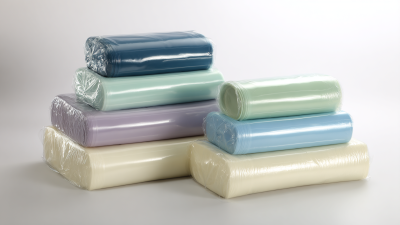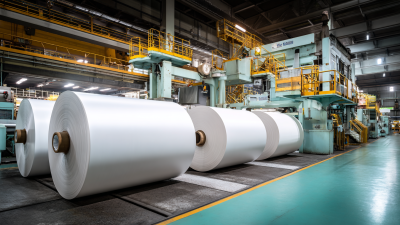The packaging industry has experienced significant growth, with the global shrink film market projected to reach $12.55 billion by 2026, according to a report by Mordor Intelligence. As businesses strive for efficiency and visual appeal in their products, the selection of the right shrink film has become a crucial decision in packaging strategies. Shrink film not only enhances the presentation of products but also provides protection during storage and transportation. However, with the variety of materials, thicknesses, and shrink ratios available, choosing the right shrink film can be a daunting task.

Understanding the specific needs of your products and considering factors such as product shape, environmental conditions, and sustainability can help in making an informed decision. In this blog, we will explore key considerations to guide you in selecting the ideal shrink film tailored to your packaging requirements.
When it comes to selecting the right shrink film for packaging, understanding the various types available in the market is crucial. The primary types include PVC (Polyvinyl Chloride), PE (Polyethylene), and PETG (Polyethylene Terephthalate Glycol). Each material has unique characteristics that cater to different packaging needs. According to a report by MarketsandMarkets, the global shrink film market is projected to reach USD 10.4 billion by 2025, with a compound annual growth rate (CAGR) of 5.5%. This growth is largely driven by the increasing demand for convenient and sustainable packaging solutions.
PVC shrink film is often favored for its clarity and shrink ratio, making it ideal for products that require high visibility on retail shelves. However, it's important to note that environmental concerns have led to a gradual decline in its usage. On the other hand, PE shrink film is gaining traction due to its recyclable nature, catering to the growing consumer preference for eco-friendly products. The flexible nature and seal strength of PE make it suitable for a wide range of applications. Lastly, PETG shines in the presentation of retail products with its glossy finish and superior impact resistance, often being the choice for high-end packaging solutions. Understanding these distinctions is vital for businesses looking to optimize their packaging strategies.
When selecting shrink film for your packaging needs, it's essential to consider the type of product you are wrapping. Different materials provide varying levels of performance and protection. For instance, polyethylene shrink film is highly affordable and provides good clarity, making it suitable for lightweight and non-perishable items. In contrast, polyolefin films offer superior strength and puncture resistance, making them ideal for products that require longer shelf life or are subjected to rough handling during transit.
Another critical consideration is the thickness of the shrink film. Thicker films tend to provide better durability and protection but may also result in higher costs. It’s important to balance the need for strength with your budget while also considering the environmental impact of your packaging choices. Moreover, think about the shrinkage percentage; films with higher shrink rates can tightly conform to the product, giving it a polished look while also reducing movement within the packaging. By evaluating these factors carefully, you can choose the right shrink film that not only enhances your product's appearance but also ensures its safety and longevity.
When choosing shrink film for your packaging needs, it is essential to consider its compatibility with various materials to ensure optimal performance. Different shrink films, such as PVC, Polyolefin, and PET, have unique properties that can affect how they interact with the items being packaged. For instance, PVC shrink film is ideal for non-food items due to its strong sealing capabilities, whereas Polyolefin is more suitable for food products because of its high clarity and non-toxic nature. Assessing these attributes based on your specific packaging requirements is crucial for maintaining the integrity and presentation of your products.
Additionally, testing compatibility involves evaluating how the shrink film reacts to the substrates it will encase. Factors such as temperature resistance, flexibility, and sealing strength play a significant role in this assessment. It’s also important to consider the shrinkage percentage of the film, as this will impact how closely it adheres to your product. Conducting surface energy tests can help determine whether a film will bond effectively to a given substrate. By understanding these elements, you can select the right shrink film that not only protects your product but also enhances its visual appeal.
| Shrink Film Type | Compatibility with Materials | Key Properties | Common Applications |
|---|---|---|---|
| PVC Shrink Film | Good with paper, cardboard | Strong, economical, translucent | Food packaging, retail packaging |
| PE Shrink Film | Compatible with plastics | Flexible, good seal strength | Bundling products, shrink wrapping |
| PET Shrink Film | Good with glass, metals | High clarity, sturdy | Bottles, containers |
| OPP Shrink Film | Good with paper, cardboard | High gloss, lightweight | Consumer goods, gift packaging |
| PLA Shrink Film | Eco-friendly, good with biodegradable products | Biodegradable, renewable | Organic products, eco-packaging |
When selecting shrink film for packaging needs, one of the most critical factors to consider is the thickness and strength of the material. Recent studies on low-density polyethylene (LDPE) have shown that the tensile properties of the film can significantly vary with different thicknesses.
 Thicker films may offer enhanced durability and resistance to punctures, which is essential for protecting products during shipping and handling. However, a thicker film is not always the best choice, as it can increase costs without necessarily providing better performance.
Thicker films may offer enhanced durability and resistance to punctures, which is essential for protecting products during shipping and handling. However, a thicker film is not always the best choice, as it can increase costs without necessarily providing better performance.
Interestingly, findings indicate that sometimes the most effective solutions are not the bulkiest. For instance, some window insulation kits have proven to deliver superior draft protection without being excessively thick. This insight highlights the importance of balancing thickness with other properties such as flexibility and weight. Ultimately, choosing the right shrink film involves assessing specific packaging needs, product fragility, and desired performance, making thickness and strength key considerations in the selection process.
When selecting shrink film for packaging, avoiding common pitfalls is essential to ensure efficiency and cost-effectiveness. One prevalent mistake is underestimating the importance of correct gauge and thickness. According to a report by Freedonia Group, the demand for flexible packaging, which includes shrink film, is projected to grow by 3.3% annually, emphasizing the need for the right materials that can withstand different environments. Using an inappropriate gauge can lead to excessive breakage or insufficient protection during transportation, potentially resulting in product loss and increased costs.

Another frequent error is neglecting to assess the compatibility of the shrink film with the packaged product. For instance, a study by Smithers Pira indicates that 66% of packaging failures are related to material selection errors. Consider factors such as the product's size, shape, and temperature sensitivity. Incorrect choices can lead to inadequate seal integrity, which may compromise the safety and freshness of perishable items. By conducting thorough evaluations and choosing the correct shrink film suited to specific products, businesses can mitigate these risks and enhance their packaging effectiveness.






